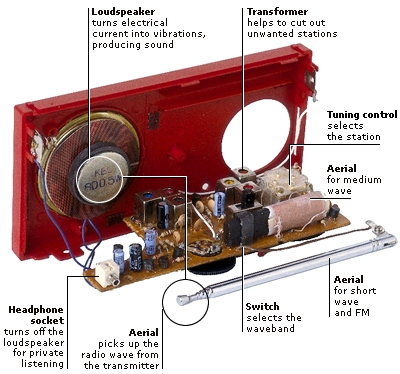DK Science: Radio
Radio depends on electricity and magnetism working together to make waves that travel through space at the speed of light. When you tune in your radio, you hear sounds that have taken a ride, in electrical form, on these radio waves. DIGITAL RADIO is a stream of digital data carrying dozens of programmes and travelling on hundreds of different radio waves.

The simplest kind of radio transmission makes the strength, or amplitude, of a radio wave copy the shape of a sound wave. This is called amplitude modulation (AM). A circuit in the receiver turns the radio waves into sound signals. These are amplified and fed to the loudspeaker.
A single radio transmission contains many different radio waves mixed together. A spectrum sorts them out according to their frequency (speed of vibration). In this AM broadcast, the frequency you tune to is the peak in the middle. The smaller peaks are other frequencies that carry the programme.
Digital radio converts each programme into digital codes, made of 1s and 0s, representing sound. It then puts together a block of codes from each programme in turn, to form a “multiplex”. This huge stream of data is divided between hundreds of radio channels. The receiver picks up all the channels at once, extracts the blocks belonging to the required programme, sticks them together again, and turns them back into sound.
A digital radio tunes to only one set of frequencies, so the radio does not need to be retuned as you move around. Digital audio broadcasting (DAB) also resists interference because it uses so many different frequencies at once. Interference usually affects only a few frequencies, so there is little effect on the programme overall.

